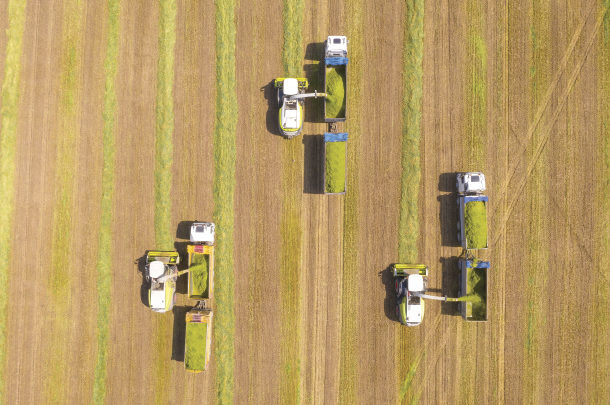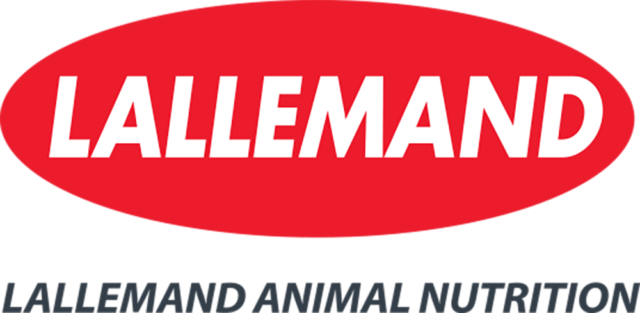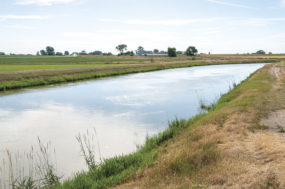Small-grain silages are among the favorite choices of beef and dairy producers, for several reasons. They offer a great way to feed high-quality grains without the hassle of mixing complicated rations and extensive feed processing. While corn is one of the first grains producers think about, wheat silage, or wheatlage, also has some incredible advantages and benefits compared to its more commonplace counterpart. While known for its capabilities as a grain, wheat has an array of forage flexibilities. It can be grown in the spring or fall and can be grown alongside many other crops and forages. Additionally, wheat is very accommodating to a variety of climates and soil types.
Wheatlage continues to gain increasing popularity, especially from the dairy sector. When harvested at the proper time, wheatlage will rival alfalfa with its high digestibility and crude protein levels.
Why wheat?
You can find wheat for grain grown almost anywhere in the continental U.S., but we find wheat grown as a forage crop primarily in livestock regions from the Midwest all the way down through the Southwest corner. In certain areas where demand for silage is very high, winter wheat makes an ideal silage source for dairy and beef cattle operations, as it can meet forage needs in the late spring and summer before corn and sorghum silages are harvested.
In many areas, silage crops are harvested about one month earlier than their grain counterpart. If there is sufficient water, winter small-grain silages such as wheat provide the opportunity to have two silage crops in one year. Wheat can be harvested and ensiled prior to corn or sorghum silage planting, then replanted later in the year after corn comes off.
In the northwestern part of the Texas Panhandle, Mike Bragg of the Texas A&M AgriLife Dallam-Hartley County Extension office says this is where wheatlage has found a fit for producers in his area.
“It also offers another option to a grain farmer to take wheat off earlier,” Bragg explains. “And that would translate into less inputs into producing a grain crop, especially water.”
Compared to high-yield corn silage, high-yielding wheatlage uses approximately 10 less acre-inches of water, making it a valuable alternative to semiarid areas. Nonetheless, water use is a function of harvest stage, environment and desired yield potential.
As is the case with silage making in general, the quality of wheatlage hangs heavily on the stage at which it is harvested. Wheat goes through four main stages of growth: tillering, stem extension, heading and grain ripening.
Wheat for silage is either chopped at boot, the last phase of the stem-extension stage, or at soft-dough stage.
The boot stage, while having less tonnage, is optimal, especially for milking dairy herds because the nutritive value of the forage is high. By the time plants reach soft-dough stage, the average crude protein drops to 8%-10%, explains Jourdan Bell, an agronomist from Texas A&M.
“Early in the boot stage, we can have crude protein levels that are 15 to 18 percent,” she continues. “When we look at the quality of that forage in the boot stage, we also have a forage that’s very digestible.”
Acid detergent fiber (ADF) provides a good indication of forage digestibility because it is a measure of plant lignin and cellulose. As plants mature, lignin levels, and consequently ADF levels, naturally increase, providing an indication of reduced digestibility.
During boot stage, ADF can be 5%-7% lower than ADF at soft-dough stage. While we see significant differences between stages, we also see significant differences between varieties. Variety selection is very important when trying to optimize both yield and nutritive value.
However, wheat chopped in the boot stage can be as high as 80% moisture. “We’re now looking at a forage that has a high moisture content, so it cannot be directly ensiled.” In these cases, wheatlage is often fed fresh as green chop or windrowed until moisture content has come down, so it can be ensiled.
Crucial considerations
Growers in search of tonnage can opt to wait until soft-dough stage when yields can increase by about 50%-100%, depending on variety and growing conditions.
“When waiting until early soft dough, we found that the forage is only about 60 to 65 percent moisture. That means it can go straight to the pit and be ensiled,” Bragg notes.
Dairy farmer Sieto Mellema of Full Circle Jerseys in Dalhart, Texas, capitalizes on both quality and quantity by chopping different wheat fields at different times.
Wheat works very well on his farm, which also grows corn silage, so by planting winter wheat, they are able to harvest in early spring and early summer then plant corn for the rest of the growing season.
“That works well for us here because as we rotate into the summer crop, it gets it out early [and] gives us time to get the land prepared for the secondary crop,” he says.
Having a large herd of about 4,700 milking head, plus some beef animals, Mellema says they are able to utilize cuttings at both the early boot and soft-dough stages.
“We do that just to increase the tonnage in the soft dough, so we’ll have a fairly good pile. And then we will have an early boot pile and a soft-dough pile that are independently used for different rations.”
In Texas, it is common for custom operators to be hired to take off wheatlage. Bragg says it takes a lot of equipment to move all the tonnage at the boot stage.
“You need to have a lot of trucks lined up, because when it’s ready, you’ve got to go,” he says. “This is all while trying to hit an optimum moisture level so [it] ensiles well.” He notes the 60%-65% moisture window for ensiling is pretty short.
With the notable trade-off between quantity and quality, fair pricing of wheatlage and securing the right product can be difficult for growers and buyers alike.
In some instances, Bragg says he observes dairy producers setting up contracts that ensure they will purchase wheatlage at the boot stage. An ideal pricing structure would be one where growers are compensated for the value of an early boot-stage harvest.
“Right now, they’re not compensated for higher quality but for weight,” he says. “It would be possible to use relative feed value [RFV], which is an index that estimates digestible dry matter from acid detergent fiber [ADF] using that alfalfa-quality scale.”
He says wheat silage is comparable to Grade #2 alfalfa (dry cow quality) and could be priced by RFV in the same way many dairies price and purchase alfalfa.
For example, if #2 alfalfa is $1.10 per point of RFV, and the feed analysis is 210 RFV, the math is done as $1.10 X 210 = $231 per ton.
“Pricing needs to still allow a profit for producers because they’re losing quite a bit of yield by taking it earlier.”











